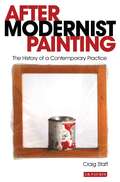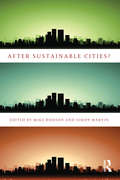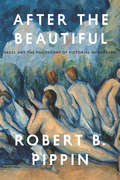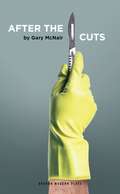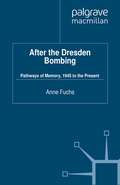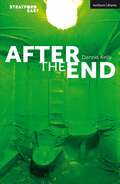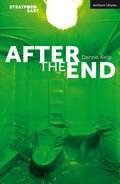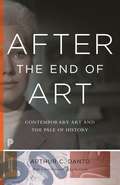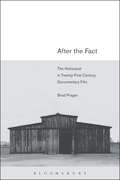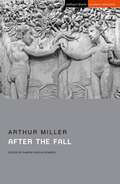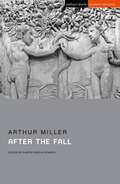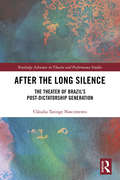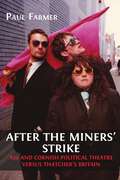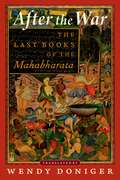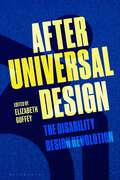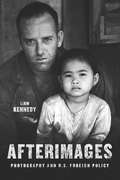- Table View
- List View
After Modernist Painting: The History of a Contemporary Practice (International Library of Modern and Contemporary Art)
by Craig StaffSince the publication of Clement Greenberg's 'Modernist Painting' in 1960, the status of painting and its continued legitimacy as a medium has been repeatedly placed under question. As such, painting has had to continually redefine its own parameters and re-negotiate for itself a critical position within a broader, more discursive set of discourses. Taking the American art critic's text as a point of departure, After Modernist Painting will be both a historical survey and a critical re-evaluation of the contested and contingent nature of the medium of painting over the last 50 years. Presenting the first critical account of painting, rather than art generally, this book provides a timely exploration of what has remained a persistent and protean medium. Craig Staff focuses on certain developments including the relationship of painting to Conceptual Art and Minimalism, the pronouncement of its alleged death, its response to Installation Art's foregrounding of site, how is was able to interpret ideas around appropriation, simulation and hybridity and how today it can be understood as both imaging and imagining the digital. After Modernist Painting is an invaluable resource for those seeking to understand the themes and issues that have pertained to painting within the context of postmodernism and contemporary artistic practice.
After Sustainable Cities?
by Mike Hodson Simon MarvinA sustainable city has been defined in many ways. Yet, the most common understanding is a vision of the city that is able to meet the needs of the present without compromising the ability of future generations to meet their own needs. Central to this vision are two ideas: cities should meet social needs, especially of the poor, and not exceed the ability of the global environment to meet needs.After Sustainable Cities critically reviews what has happened to these priorities and asks whether these social commitments have been abandoned in a period of austerity governance and climate change and replaced by a darker and unfair city. This book provides the first comprehensive and comparative analysis of the new eco-logics reshaping conventional sustainable cities discourse and environmental priorities of cities in both the global north and south. The dominant discourse on sustainable cities, with a commitment to intergenerational equity, social justice and global responsibility, has come under increasing pressure. Under conditions of global ecological change, international financial and economic crisis and austerity governance new eco-logics are entering the urban sustainability lexicon – climate change, green growth, smart growth, resilience and vulnerability, ecological security. This book explores how these new eco-logics reshape our understanding of equity, justice and global responsibility, and how these more technologically and economically driven themes resonate and dissonate with conventional sustainable cities discourse. This book provides a warning that a more technologically driven and narrowly constructed economic agenda is driving ecological policy and weakening previous commitment to social justice and equity. After Sustainable Cities brings together leading researchers to provide a critical examination of these new logics and identity what sort of city is now emerging, as well as consider the longer-term implication on sustainable cities research and policy.
After Sustainable Cities?
by Mike Hodson Simon MarvinA sustainable city has been defined in many ways. Yet, the most common understanding is a vision of the city that is able to meet the needs of the present without compromising the ability of future generations to meet their own needs. Central to this vision are two ideas: cities should meet social needs, especially of the poor, and not exceed the ability of the global environment to meet needs.After Sustainable Cities critically reviews what has happened to these priorities and asks whether these social commitments have been abandoned in a period of austerity governance and climate change and replaced by a darker and unfair city. This book provides the first comprehensive and comparative analysis of the new eco-logics reshaping conventional sustainable cities discourse and environmental priorities of cities in both the global north and south. The dominant discourse on sustainable cities, with a commitment to intergenerational equity, social justice and global responsibility, has come under increasing pressure. Under conditions of global ecological change, international financial and economic crisis and austerity governance new eco-logics are entering the urban sustainability lexicon – climate change, green growth, smart growth, resilience and vulnerability, ecological security. This book explores how these new eco-logics reshape our understanding of equity, justice and global responsibility, and how these more technologically and economically driven themes resonate and dissonate with conventional sustainable cities discourse. This book provides a warning that a more technologically driven and narrowly constructed economic agenda is driving ecological policy and weakening previous commitment to social justice and equity. After Sustainable Cities brings together leading researchers to provide a critical examination of these new logics and identity what sort of city is now emerging, as well as consider the longer-term implication on sustainable cities research and policy.
After the Beautiful: Hegel and the Philosophy of Pictorial Modernism
by Robert B. PippinIn his Berlin lectures on fine art, Hegel argued that art involves a unique form of aesthetic intelligibility—the expression of a distinct collective self-understanding that develops through historical time. Hegel’s approach to art has been influential in a number of different contexts, but in a twist of historical irony Hegel would die just before the most radical artistic revolution in history: modernism. In After the Beautiful, Robert B. Pippin, looking at modernist paintings by artists such as Édouard Manet and Paul Cézanne through Hegel’s lens, does what Hegel never had the chance to do. While Hegel could never engage modernist painting, he did have an understanding of modernity, and in it, art—he famously asserted—was “a thing of the past,” no longer an important vehicle of self-understanding and no longer an indispensable expression of human meaning. Pippin offers a sophisticated exploration of Hegel’s position and its implications. He also shows that had Hegel known how the social institutions of his day would ultimately fail to achieve his own version of genuine equality, a mutuality of recognition, he would have had to explore a different, new role for art in modernity. After laying this groundwork, Pippin goes on to illuminate the dimensions of Hegel’s aesthetic approach in the path-breaking works of Manet, the “grandfather of modernism,” drawing on art historians T. J. Clark and Michael Fried to do so. He concludes with a look at Cézanne, the “father of modernism,” this time as his works illuminate the relationship between Hegel and the philosopher who would challenge Hegel’s account of both modernity and art—Martin Heidegger. Elegantly inter-weaving philosophy and art history, After the Beautiful is a stunning reassessment of the modernist project. It gets at the core of the significance of modernism itself and what it means in general for art to have a history. Ultimately, it is a testament, via Hegel, to the distinctive philosophical achievements of modernist art in the unsettled, tumultuous era we have inherited.
After the Beautiful: Hegel and the Philosophy of Pictorial Modernism
by Robert B. PippinIn his Berlin lectures on fine art, Hegel argued that art involves a unique form of aesthetic intelligibility—the expression of a distinct collective self-understanding that develops through historical time. Hegel’s approach to art has been influential in a number of different contexts, but in a twist of historical irony Hegel would die just before the most radical artistic revolution in history: modernism. In After the Beautiful, Robert B. Pippin, looking at modernist paintings by artists such as Édouard Manet and Paul Cézanne through Hegel’s lens, does what Hegel never had the chance to do. While Hegel could never engage modernist painting, he did have an understanding of modernity, and in it, art—he famously asserted—was “a thing of the past,” no longer an important vehicle of self-understanding and no longer an indispensable expression of human meaning. Pippin offers a sophisticated exploration of Hegel’s position and its implications. He also shows that had Hegel known how the social institutions of his day would ultimately fail to achieve his own version of genuine equality, a mutuality of recognition, he would have had to explore a different, new role for art in modernity. After laying this groundwork, Pippin goes on to illuminate the dimensions of Hegel’s aesthetic approach in the path-breaking works of Manet, the “grandfather of modernism,” drawing on art historians T. J. Clark and Michael Fried to do so. He concludes with a look at Cézanne, the “father of modernism,” this time as his works illuminate the relationship between Hegel and the philosopher who would challenge Hegel’s account of both modernity and art—Martin Heidegger. Elegantly inter-weaving philosophy and art history, After the Beautiful is a stunning reassessment of the modernist project. It gets at the core of the significance of modernism itself and what it means in general for art to have a history. Ultimately, it is a testament, via Hegel, to the distinctive philosophical achievements of modernist art in the unsettled, tumultuous era we have inherited.
After the Beautiful: Hegel and the Philosophy of Pictorial Modernism
by Robert B. PippinIn his Berlin lectures on fine art, Hegel argued that art involves a unique form of aesthetic intelligibility—the expression of a distinct collective self-understanding that develops through historical time. Hegel’s approach to art has been influential in a number of different contexts, but in a twist of historical irony Hegel would die just before the most radical artistic revolution in history: modernism. In After the Beautiful, Robert B. Pippin, looking at modernist paintings by artists such as Édouard Manet and Paul Cézanne through Hegel’s lens, does what Hegel never had the chance to do. While Hegel could never engage modernist painting, he did have an understanding of modernity, and in it, art—he famously asserted—was “a thing of the past,” no longer an important vehicle of self-understanding and no longer an indispensable expression of human meaning. Pippin offers a sophisticated exploration of Hegel’s position and its implications. He also shows that had Hegel known how the social institutions of his day would ultimately fail to achieve his own version of genuine equality, a mutuality of recognition, he would have had to explore a different, new role for art in modernity. After laying this groundwork, Pippin goes on to illuminate the dimensions of Hegel’s aesthetic approach in the path-breaking works of Manet, the “grandfather of modernism,” drawing on art historians T. J. Clark and Michael Fried to do so. He concludes with a look at Cézanne, the “father of modernism,” this time as his works illuminate the relationship between Hegel and the philosopher who would challenge Hegel’s account of both modernity and art—Martin Heidegger. Elegantly inter-weaving philosophy and art history, After the Beautiful is a stunning reassessment of the modernist project. It gets at the core of the significance of modernism itself and what it means in general for art to have a history. Ultimately, it is a testament, via Hegel, to the distinctive philosophical achievements of modernist art in the unsettled, tumultuous era we have inherited.
After the Beautiful: Hegel and the Philosophy of Pictorial Modernism
by Robert B. PippinIn his Berlin lectures on fine art, Hegel argued that art involves a unique form of aesthetic intelligibility—the expression of a distinct collective self-understanding that develops through historical time. Hegel’s approach to art has been influential in a number of different contexts, but in a twist of historical irony Hegel would die just before the most radical artistic revolution in history: modernism. In After the Beautiful, Robert B. Pippin, looking at modernist paintings by artists such as Édouard Manet and Paul Cézanne through Hegel’s lens, does what Hegel never had the chance to do. While Hegel could never engage modernist painting, he did have an understanding of modernity, and in it, art—he famously asserted—was “a thing of the past,” no longer an important vehicle of self-understanding and no longer an indispensable expression of human meaning. Pippin offers a sophisticated exploration of Hegel’s position and its implications. He also shows that had Hegel known how the social institutions of his day would ultimately fail to achieve his own version of genuine equality, a mutuality of recognition, he would have had to explore a different, new role for art in modernity. After laying this groundwork, Pippin goes on to illuminate the dimensions of Hegel’s aesthetic approach in the path-breaking works of Manet, the “grandfather of modernism,” drawing on art historians T. J. Clark and Michael Fried to do so. He concludes with a look at Cézanne, the “father of modernism,” this time as his works illuminate the relationship between Hegel and the philosopher who would challenge Hegel’s account of both modernity and art—Martin Heidegger. Elegantly inter-weaving philosophy and art history, After the Beautiful is a stunning reassessment of the modernist project. It gets at the core of the significance of modernism itself and what it means in general for art to have a history. Ultimately, it is a testament, via Hegel, to the distinctive philosophical achievements of modernist art in the unsettled, tumultuous era we have inherited.
After the Beautiful: Hegel and the Philosophy of Pictorial Modernism
by Robert B. PippinIn his Berlin lectures on fine art, Hegel argued that art involves a unique form of aesthetic intelligibility—the expression of a distinct collective self-understanding that develops through historical time. Hegel’s approach to art has been influential in a number of different contexts, but in a twist of historical irony Hegel would die just before the most radical artistic revolution in history: modernism. In After the Beautiful, Robert B. Pippin, looking at modernist paintings by artists such as Édouard Manet and Paul Cézanne through Hegel’s lens, does what Hegel never had the chance to do. While Hegel could never engage modernist painting, he did have an understanding of modernity, and in it, art—he famously asserted—was “a thing of the past,” no longer an important vehicle of self-understanding and no longer an indispensable expression of human meaning. Pippin offers a sophisticated exploration of Hegel’s position and its implications. He also shows that had Hegel known how the social institutions of his day would ultimately fail to achieve his own version of genuine equality, a mutuality of recognition, he would have had to explore a different, new role for art in modernity. After laying this groundwork, Pippin goes on to illuminate the dimensions of Hegel’s aesthetic approach in the path-breaking works of Manet, the “grandfather of modernism,” drawing on art historians T. J. Clark and Michael Fried to do so. He concludes with a look at Cézanne, the “father of modernism,” this time as his works illuminate the relationship between Hegel and the philosopher who would challenge Hegel’s account of both modernity and art—Martin Heidegger. Elegantly inter-weaving philosophy and art history, After the Beautiful is a stunning reassessment of the modernist project. It gets at the core of the significance of modernism itself and what it means in general for art to have a history. Ultimately, it is a testament, via Hegel, to the distinctive philosophical achievements of modernist art in the unsettled, tumultuous era we have inherited.
After the Beautiful: Hegel and the Philosophy of Pictorial Modernism
by Robert B. PippinIn his Berlin lectures on fine art, Hegel argued that art involves a unique form of aesthetic intelligibility—the expression of a distinct collective self-understanding that develops through historical time. Hegel’s approach to art has been influential in a number of different contexts, but in a twist of historical irony Hegel would die just before the most radical artistic revolution in history: modernism. In After the Beautiful, Robert B. Pippin, looking at modernist paintings by artists such as Édouard Manet and Paul Cézanne through Hegel’s lens, does what Hegel never had the chance to do. While Hegel could never engage modernist painting, he did have an understanding of modernity, and in it, art—he famously asserted—was “a thing of the past,” no longer an important vehicle of self-understanding and no longer an indispensable expression of human meaning. Pippin offers a sophisticated exploration of Hegel’s position and its implications. He also shows that had Hegel known how the social institutions of his day would ultimately fail to achieve his own version of genuine equality, a mutuality of recognition, he would have had to explore a different, new role for art in modernity. After laying this groundwork, Pippin goes on to illuminate the dimensions of Hegel’s aesthetic approach in the path-breaking works of Manet, the “grandfather of modernism,” drawing on art historians T. J. Clark and Michael Fried to do so. He concludes with a look at Cézanne, the “father of modernism,” this time as his works illuminate the relationship between Hegel and the philosopher who would challenge Hegel’s account of both modernity and art—Martin Heidegger. Elegantly inter-weaving philosophy and art history, After the Beautiful is a stunning reassessment of the modernist project. It gets at the core of the significance of modernism itself and what it means in general for art to have a history. Ultimately, it is a testament, via Hegel, to the distinctive philosophical achievements of modernist art in the unsettled, tumultuous era we have inherited.
After the Cuts (Oberon Modern Plays)
by Gary McNairIt's the future; just like now, but a bit more... well, sh*tey. Jim and Agnes have worked hard their whole lives and now Agnes needs a life-saving operation.With the NHS as we know it a thing of the past, they must take matters into their own hands in this darkly comic tale. What lengths will people go to for life and love?
After the Dresden Bombing: Pathways of Memory, 1945 to the Present (Palgrave Macmillan Memory Studies)
by A. FuchsAnne Fuchs traces the aftermath of the Dresden bombing in the collective imagination from 1945 to today. As a case study of an event that gained local, national and global iconicity, the book investigates the role of photography, fine art, architecture, literature and film in dialogue with the changing German socio-political landscape.
After the End (Modern Plays)
by Dennis KellyA city under attack from a nuclear blast. As the dust settles, Louise wakes to find herself in a fallout shelter with Mark, the colleague who has saved her life. They have enough water and food to last two weeks. Now they just need to find a way of surviving each other. A chilling post-nuclear play that examines what it takes to endure catastrophe.After the End was originally published in 2005. This revised and updated edition was published to coincide with the London production at Theatre Royal Stratford East in February 2022.
After the End (Modern Plays)
by Dennis KellyA city under attack from a nuclear blast. As the dust settles, Louise wakes to find herself in a fallout shelter with Mark, the colleague who has saved her life. They have enough water and food to last two weeks. Now they just need to find a way of surviving each other. A chilling post-nuclear play that examines what it takes to endure catastrophe.After the End was originally published in 2005. This revised and updated edition was published to coincide with the London production at Theatre Royal Stratford East in February 2022.
After the End of Art: Contemporary Art and the Pale of History - Updated Edition (Princeton Classics #112)
by Arthur C. DantoOver a decade ago, Arthur Danto announced that art ended in the sixties. Ever since this declaration, he has been at the forefront of a radical critique of the nature of art in our time. After the End of Art presents Danto's first full-scale reformulation of his original insight, showing how, with the eclipse of abstract expressionism, art has deviated irrevocably from the narrative course that Vasari helped define for it in the Renaissance. Moreover, he leads the way to a new type of criticism that can help us understand art in a posthistorical age where, for example, an artist can produce a work in the style of Rembrandt to create a visual pun, and where traditional theories cannot explain the difference between Andy Warhol's Brillo Box and the product found in the grocery store. Here we are engaged in a series of insightful and entertaining conversations on the most relevant aesthetic and philosophical issues of art, conducted by an especially acute observer of the art scene today. Originally delivered as the prestigious Mellon Lectures on the Fine Arts, these writings cover art history, pop art, "people's art," the future role of museums, and the critical contributions of Clement Greenberg--who helped make sense of modernism for viewers over two generations ago through an aesthetics-based criticism. Tracing art history from a mimetic tradition (the idea that art was a progressively more adequate representation of reality) through the modern era of manifestos (when art was defined by the artist's philosophy), Danto shows that it wasn't until the invention of Pop art that the historical understanding of the means and ends of art was nullified. Even modernist art, which tried to break with the past by questioning the ways of producing art, hinged on a narrative. Traditional notions of aesthetics can no longer apply to contemporary art, argues Danto. Instead he focuses on a philosophy of art criticism that can deal with perhaps the most perplexing feature of contemporary art: that everything is possible.
After the Fact: The Holocaust in Twenty-First Century Documentary Film
by Brad PragerAfter the Fact studies the terrain of Holocaust documentaries subsequent to the turn of the twenty-first century. Until now most studies have centered primarily on canonical films such as Shoah and Night and Fog, but over the course of the last ten years filmmaking practices have altered dramatically. Changing techniques, diminishing communities of survivors, and the public's response to familiar, even iconic imagery, have all challenged filmmakers to radically revise and newly envision how they depict the Holocaust. Innovative styles have emerged, including groundbreaking techniques of incorporating archival footage, survivor testimony, and reenactment. Carrying wider implications for the fields of Film Studies, Jewish Studies, and Visual Studies, this book closely analyzes ten contemporary and internationally produced films, most of which have hardly been touched upon in the critical literature or elsewhere.
After the Fact: The Holocaust in Twenty-First Century Documentary Film
by Brad PragerAfter the Fact studies the terrain of Holocaust documentaries subsequent to the turn of the twenty-first century. Until now most studies have centered primarily on canonical films such as Shoah and Night and Fog, but over the course of the last ten years filmmaking practices have altered dramatically. Changing techniques, diminishing communities of survivors, and the public's response to familiar, even iconic imagery, have all challenged filmmakers to radically revise and newly envision how they depict the Holocaust. Innovative styles have emerged, including groundbreaking techniques of incorporating archival footage, survivor testimony, and reenactment. Carrying wider implications for the fields of Film Studies, Jewish Studies, and Visual Studies, this book closely analyzes ten contemporary and internationally produced films, most of which have hardly been touched upon in the critical literature or elsewhere.
After the Fall: The Misfits; After The Fall; Incident At Vichy; The Price; Creation Of The World; Playing For Time (Student Editions)
by Arthur Miller'Much like Mr. Miller, Quentin is a witness to alarming public and personal catastrophes: the stock market crash, the Holocaust, the McCarthy witchhunts and the self-destruction of a show business idol to whom he is married.' NEW YORK TIMESHaunted by past romantic failures, Quentin, a New York City Jewish intellectual, retreats into his mind as he debates marrying for a third time: as he revisits past loves and losses, his mind and memory fragments under philosophical questions; are our failures really just our own? Or is possible to hide away from the mistakes of the past?One of Miller's most personal plays, After the Fall takes place almost entirely inside the mind of the play's protagonist, who is often read as a stand-in for the playwright himself. Touching on themes of the Holocaust, McCarthyism and inherited sin, the play is one of the most discussed within Miller's canon.This Methuen Drama Student Edition is edited by Ramón Espejo-Romero, with commentary and notes that explore the play's production history (including excerpts from an interview with Michael Blakemore, former Associate Director of the Royal National Theatre,) as well as the dramatic, thematic and academic debates that surround it.
After the Fall (Student Editions)
by Arthur Miller'Much like Mr. Miller, Quentin is a witness to alarming public and personal catastrophes: the stock market crash, the Holocaust, the McCarthy witchhunts and the self-destruction of a show business idol to whom he is married.' NEW YORK TIMESHaunted by past romantic failures, Quentin, a New York City Jewish intellectual, retreats into his mind as he debates marrying for a third time: as he revisits past loves and losses, his mind and memory fragments under philosophical questions; are our failures really just our own? Or is possible to hide away from the mistakes of the past?One of Miller's most personal plays, After the Fall takes place almost entirely inside the mind of the play's protagonist, who is often read as a stand-in for the playwright himself. Touching on themes of the Holocaust, McCarthyism and inherited sin, the play is one of the most discussed within Miller's canon.This Methuen Drama Student Edition is edited by Ramón Espejo-Romero, with commentary and notes that explore the play's production history (including excerpts from an interview with Michael Blakemore, former Associate Director of the Royal National Theatre,) as well as the dramatic, thematic and academic debates that surround it.
After the Long Silence: The Theater of Brazil’s Post-Dictatorship Generation (Routledge Advances in Theatre & Performance Studies)
by Claudia Tatinge NascimentoAfter the Long Silence offers a ground-breaking, meticulously researched criticism of Brazilian contemporary performance created by its post-dictatorship generation, whose work expresses the consequences of decades of state-imposed censorship. By offering an in-depth examination of key artists and their works, Cláudia Tatinge Nascimento highlights Brazil’s political trajectory while never allowing the weight of historical events to offset key aesthetic trends. Brazilian theater artists born around the time of the nation’s 1964 military coup experienced the oppressive rule of dictatorship throughout their formative years, but came of age as Brazil re-entered democracy some two decades later. This book showcases how the post-dictatorship generation developed performances that mapped the uncharted territories of Brazil’s political trauma with new dramaturgies, site-specific and street productions, and aesthetic experimentation. The author’s in-depth research into a wide array of archival materials and publications in both Portuguese and English demonstrates how the artistic practices of significant post-dictatorship artists such as Cia. dos Atores, Teatro da Vertigem, Grupo Galpão, Os Fofos Encenam, and Newton Moreno were driven by critical thinking and a postcolonial sentiment, proving symptomatic of the nation’s shift from an ethos of half-truth telling into a transitional justice that fell short in affirming citizenship. Ideal for scholars of the intersection of theatre and politics, After the Long Silence: The Theater of Brazil’s Post-Dictatorship Generation offers insight into the function of theater in times of political turmoil and artmaking practices that emerge in response to oppressive regimes.
After the Long Silence: The Theater of Brazil’s Post-Dictatorship Generation (Routledge Advances in Theatre & Performance Studies)
by Claudia Tatinge NascimentoAfter the Long Silence offers a ground-breaking, meticulously researched criticism of Brazilian contemporary performance created by its post-dictatorship generation, whose work expresses the consequences of decades of state-imposed censorship. By offering an in-depth examination of key artists and their works, Cláudia Tatinge Nascimento highlights Brazil’s political trajectory while never allowing the weight of historical events to offset key aesthetic trends. Brazilian theater artists born around the time of the nation’s 1964 military coup experienced the oppressive rule of dictatorship throughout their formative years, but came of age as Brazil re-entered democracy some two decades later. This book showcases how the post-dictatorship generation developed performances that mapped the uncharted territories of Brazil’s political trauma with new dramaturgies, site-specific and street productions, and aesthetic experimentation. The author’s in-depth research into a wide array of archival materials and publications in both Portuguese and English demonstrates how the artistic practices of significant post-dictatorship artists such as Cia. dos Atores, Teatro da Vertigem, Grupo Galpão, Os Fofos Encenam, and Newton Moreno were driven by critical thinking and a postcolonial sentiment, proving symptomatic of the nation’s shift from an ethos of half-truth telling into a transitional justice that fell short in affirming citizenship. Ideal for scholars of the intersection of theatre and politics, After the Long Silence: The Theater of Brazil’s Post-Dictatorship Generation offers insight into the function of theater in times of political turmoil and artmaking practices that emerge in response to oppressive regimes.
After the Miners’ Strike A39 and Cornish Political Theatre versus Thatcher’s Britain: (pdf)
by Paul FarmerIn this rich memoir, the first of two volumes, Paul Farmer traces the story of A39, the Cornish political theatre group he co-founded and ran from the mid-1980s to the early 1990s. Farmer offers a unique insight into A39’s creation, operation, and artistic practice during a period of convulsive political and social change. The reader is plunged into the national miners’ strike and the collapse of Cornish tin mining, the impact of Thatcherism and ‘Reaganomics’, and the experience of touring Germany on the brink of reunification, alongside the influence on A39 of writers Bertolt Brecht, John McGrath and Keith Johnstone. Farmer, a former bus driver turned artistic director, details the theatre group’s inception and development as it fought to break down social barriers, attract audiences, and survive with little more than a beaten-up Renault 12, a photocopier and two second-hand stage lights at its disposal: the book traces the progress from these raw materials to the development of an integrated community theatre practice for Cornwall. Farmer’s candour and humour enliven this unique insight into 1980s theatre and politics. It will appeal to anyone with an interest in theatre history, life in Cornwall, and the relationship between performance and society during a turbulent era.
After the War: The Last Books of the Mahabharata
by Wendy DonigerAfter the War is a new translation of the final part of the Mahabharata, the great Sanskrit Epic poem about a devastating fraternal war. In this aftermath of the great war, the surviving heroes find various deaths, ranging from a drunken debacle in which they kill many of their own comrades to suicide through meditation and, finally, magical transportation to both heaven and hell. Bereaved mothers and widows on earth are comforted when their dead sons and husbands are magically conjured up from heaven and emerge from a river to spend one glorious night on earth with their loved ones. Ultimately, the bitterly opposed heroes of both sides are reconciled in heaven, but only when they finally let go of the vindictive masculine pride that has made each episode of violence give rise to another. Throughout the text, issues of truth and reconciliation, of the competing beliefs in various afterlives, and of the ultimate purpose of human life are debated. This last part of the Mahabharata has much to tell us both about the deep wisdom of Indian poets during the centuries from 300 BCE to 300 CE (the dates of the recension of this enormous text) and about the problems that we ourselves confront in the aftermath of our own genocidal and internecine wars. The author, a distinguished translator of Sanskrit texts (including the Rig Veda, the Laws of Manu, and the Kamasutra), puts the text into clear, flowing, contemporary prose, with a comprehensive but unintrusive critical apparatus. This book will delight general readers and enlighten students of Indian civilization and of great world literature.
After Universal Design: The Disability Design Revolution
by Elizabeth GuffeyHow might we develop products made with and by disabled users rather than for them? Could we change living and working spaces to make them accessible rather than designing products that "fix" disabilities? How can we grow our capabilities to make designs more “bespoke” to each individual? After Universal Design brings together scholars, practitioners, and disabled users and makers to consider these questions and to argue for the necessity of a new user-centered design. As many YouTube videos demonstrate, disabled designers are not only fulfilling the grand promises of DIY design but are also questioning what constitutes meaningful design itself. By forcing a rethink of the top-down professionalized practice of Universal Design, which has dominated thinking and practice around design for disability for decades, this book models what inclusive design and social justice can look like as activism, academic research, and everyday life practices today. With chapters, case studies, and interviews exploring questions of design and personal agency, hardware and spaces, the experiences of prosthetics' users, conventional hearing aid devices designed to suit personal style, and ways of facilitating pain self-reporting, these essays expand our understanding of what counts as design by offering alternative narratives about creativity and making. Using critical perspectives on disability, race, and gender, this book allow us to understand how design often works in the real world and challenges us to rethink ideas of "inclusion" in design.
After Universal Design: The Disability Design Revolution
How might we develop products made with and by disabled users rather than for them? Could we change living and working spaces to make them accessible rather than designing products that "fix" disabilities? How can we grow our capabilities to make designs more “bespoke” to each individual? After Universal Design brings together scholars, practitioners, and disabled users and makers to consider these questions and to argue for the necessity of a new user-centered design. As many YouTube videos demonstrate, disabled designers are not only fulfilling the grand promises of DIY design but are also questioning what constitutes meaningful design itself. By forcing a rethink of the top-down professionalized practice of Universal Design, which has dominated thinking and practice around design for disability for decades, this book models what inclusive design and social justice can look like as activism, academic research, and everyday life practices today. With chapters, case studies, and interviews exploring questions of design and personal agency, hardware and spaces, the experiences of prosthetics' users, conventional hearing aid devices designed to suit personal style, and ways of facilitating pain self-reporting, these essays expand our understanding of what counts as design by offering alternative narratives about creativity and making. Using critical perspectives on disability, race, and gender, this book allow us to understand how design often works in the real world and challenges us to rethink ideas of "inclusion" in design.
Afterimages: Photography and U.S. Foreign Policy
by Liam KennedyIn 2005, photographer Chris Hondros captured a striking image of a young Iraqi girl in the aftermath of the killing of her parents by American soldiers. The shot stunned the world and has since become iconic—comparable to the infamous photo by Nick Ut of a Vietnamese girl running from a napalm attack. Both images serve as microcosms for their respective conflicts. Afterimages looks at the work of war photographers like Hondros and Ut to understand how photojournalism interacts with the American worldview. Liam Kennedy here maps the evolving relations between the American way of war and photographic coverage of it. Organized in its first section around key US military actions over the last fifty years, the book then moves on to examine how photographers engaged with these conflicts on wider ethical and political grounds, and finally on to the genre of photojournalism itself. Illustrated throughout with examples of the photographs being considered, Afterimages argues that photographs are important means for critical reflection on war, violence, and human rights. It goes on to analyze the high ethical, sociopolitical, and legalistic value we place on the still image’s ability to bear witness and stimulate action.
